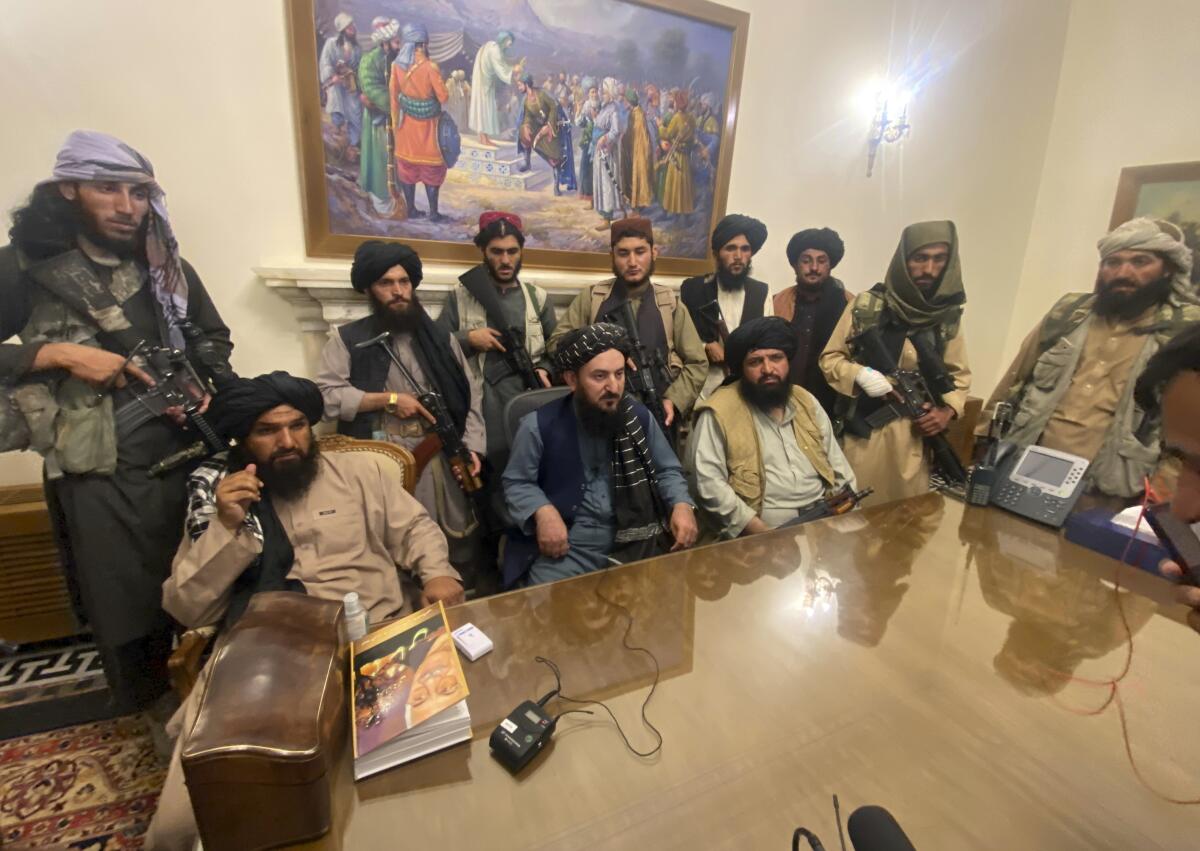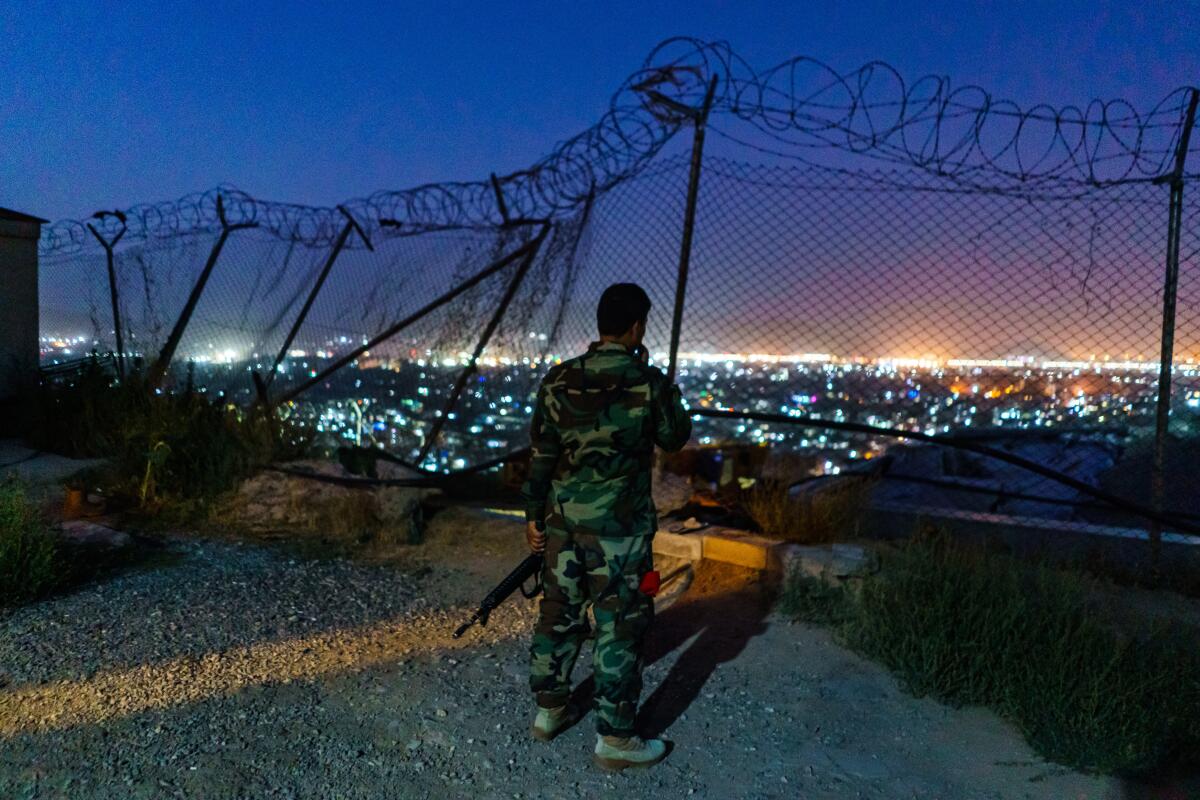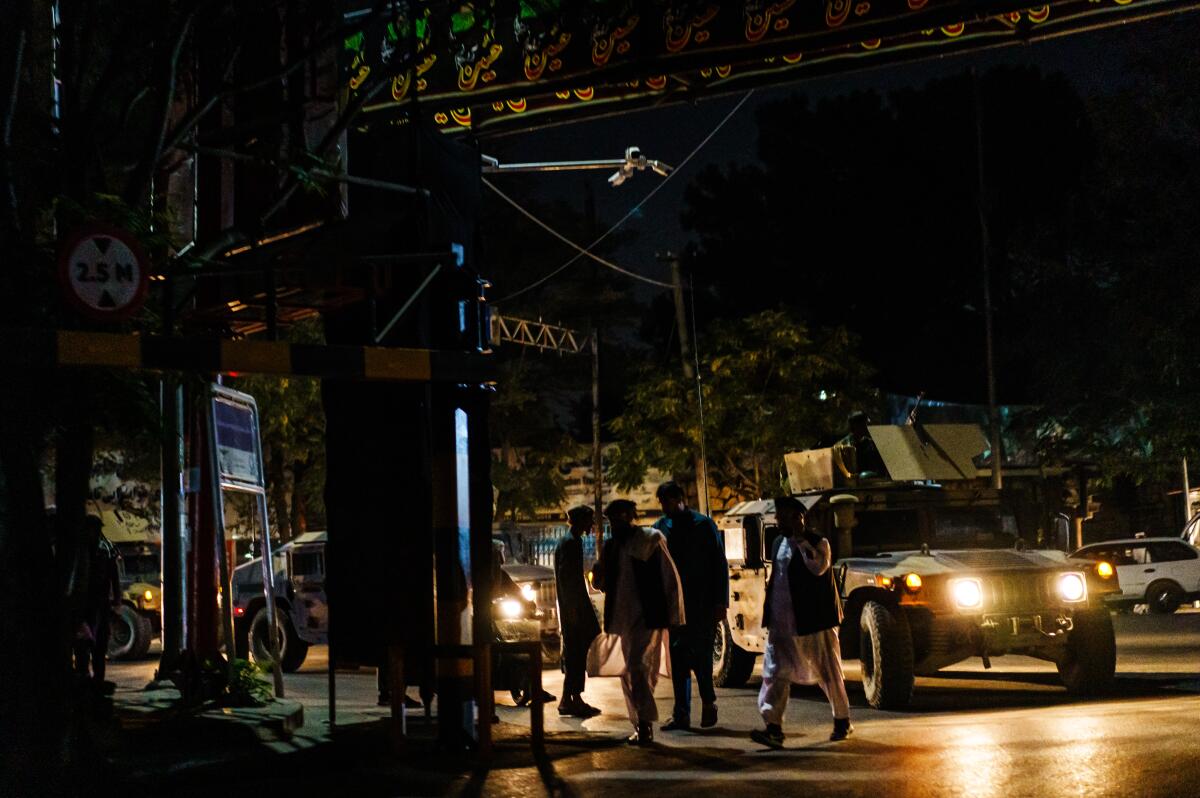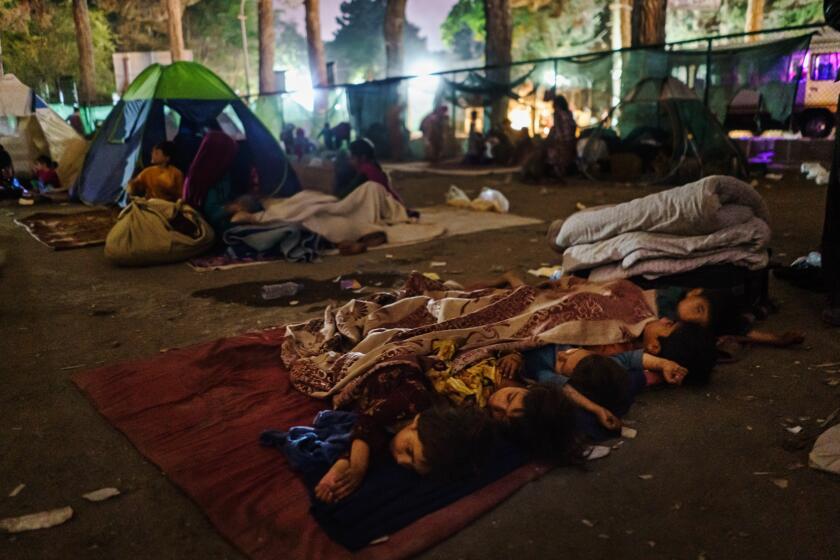Taliban floods Kabul, president flees and Afghan government collapses; U.S. rapidly evacuates

Their takeover of Afghanistan complete, Taliban militants moved into the capital, Kabul, on Sunday, occupied the presidential palace and demanded the unconditional surrender of the Afghan government against a steady thrum of helicopters ferrying Americans and other foreigners attempting to escape to safety.
Afghan President Ashraf Ghani, who the day before aired a taped message of encouragement to the public, fled the country, associates said. His departure leaves a vacuum that the Islamist insurgent group is expected to fill quickly.
The swift and humiliating defeat of two decades’ worth of U.S.-led efforts to remake Afghanistan opened a new and uncertain chapter in which Afghans opposed to the Taliban fear a return to its brutal medieval ruling style that eliminated civil rights, subjugated women and scorned education.
From early hours Sunday, thousands of panicked Afghans stormed cash machines, pushed streets into massive gridlock complete with fistfights, and hunkered down in their homes as offices, including government agencies, emptied and shops boarded up against looters. At night, the streets turned quiet, as if in terrified anticipation of what is to come.
But chaos at the Kabul airport, with thousands of desperate people trying to get out of the country, prompted the Pentagon to dispatch an additional 1,000 troops to Afghanistan to join another 4,000 deployed in the last 72 hours.
An 8 p.m. curfew was imposed, presumably by the Taliban, and a white Taliban flag was seen flying above the presidential palace. The Al Jazeera television network broadcast images it said showed armed Taliban militants walking the halls of the palace and sitting in its opulent chambers, at Ghani’s desk.
Twenty years after the U.S. invaded Afghanistan to topple the Taliban and eliminate a safe haven for Al Qaeda terrorists who attacked New York and Washington on Sept. 11, 2001, and after investing more than $80 billion to build up an Afghan army and then government institutions, the very same group, the Taliban, was returning to rule, with the U.S. beating a hasty retreat.

“The Taliban have won with the judgment of their swords and guns, and are now responsible for the honor, property and self-preservation of their countrymen,” the Taliban’s top political official, Mullah Abdul Ghani Baradar, said in proclaiming victory, according to Al Jazeera.
As Taliban insurgents streamed through the capital Sunday, the evacuation of the U.S. Embassy shifted into full gear and was completed by day’s end. Helicopters airlifted American diplomats to the fortified airport to await departure. In the last hours, diplomats destroyed sensitive files, trashed laptops and disabled cellular telephones. The U.S. flag was reportedly lowered and removed as the most senior embassy officials departed.
Several other Western embassies were also closing.

Sporadic gunfire was heard through the day and night. It was unclear if that came from skirmishes or was celebratory. After nightfall, Afghan soldiers who had been manning checkpoints vanished for the most part; some could be seen changing out of their uniforms into civilian clothes.
“Today will be the end of our life,” a woman who gave her name as Shakila Sarwari, 22, said in an interview. Like tens of thousands of Afghans, she works for one of the Western agencies that have been operating in the country for nearly two decades and fears she will be an immediate target of the Taliban.
A large contingent of soldiers was posted outside the United Nations compound, and streets to the government palace were blocked off, possibly in anticipation of the arrival of a Taliban delegation.
Abdullah Abdullah, who headed the government delegation in talks with the Taliban that were taking place in Doha, Qatar, said in a video message that Ghani had left Afghanistan.
“God will hold him accountable and the people of Afghanistan will make their judgment,” Abdullah said. Though on the same side, he and Ghani have long been rivals, with the president refusing demands he resign in order to reach a peace deal with the Taliban.
Later, Ghani issued his own social media declaration, saying he made the painful choice of either leaving the country he loved or being executed by Taliban militants.
The Taliban claimed fighters were entering the city only to protect against looting and disorder as Afghan government security melts away. “We do not want to enter Kabul by military means,” the Taliban leadership said in a statement.

“The citizens of Kabul should not feel any fear from the mujahedin,” the statement said, using the term Taliban militants call themselves, adding that fighters “are not allowed to enter someone’s home, or to harass or annoy anyone.”
With astounding speed, the Taliban launched a relentless march across the country barely two weeks ago, capturing territory and then provincial capitals and finally major cities. Even as U.S. intelligence was forecasting it would take the Taliban a month or more to seize Kabul — and as President Biden and other U.S. officials insisted the fall of the capital was not inevitable — Taliban fighters had surrounded the city of 6 million by Sunday and were moving in by nightfall.
Tens of thousands of desperate, displaced Afghans find makeshift shelter in Kabul, itself in peril
Biden, who had recently announced that all U.S. forces would leave Afghanistan by September, on Thursday dispatched a contingent of 3,000 U.S. Marines and soldiers to help evacuate the embassy and to transport some of the estimated 20,000 Afghans who worked for the U.S. and are in acute danger. On Saturday, he added 1,000 more troops to Afghanistan to aid in the fast-deteriorating crisis.
The embassy had been evacuated by Sunday night, with staff at the airport or having already flown out of the country. In daylight hours, smoke could be seen rising from the diplomatic compound as officials burned sensitive material. Although the State Department initially insisted it was not shutting down the embassy altogether, those plans are now in flux.
Helicopters began shuttling staff from the embassy earlier Sunday, hours after the Taliban seized nearby Jalalabad, the last major city besides the capital not already in its hands.
Despite the collapse of the Afghan government and with criticism mounting, the administration seemed steadfastly unwilling to reverse its decision to withdraw all American troops and has pointed fingers of blame at a lack of leadership in the badly demoralized Afghan government forces. Critics say the abrupt departure of U.S. and NATO troops emboldened the Taliban.
“One more year, or five more years, of U.S. military presence would not have made a difference if the Afghan military cannot or will not hold its own country,” Biden said in a statement Saturday.
Abrarullah Murad, a lawmaker from the province where Jalalabad is, said the insurgents seized the city after elders negotiated the fall of the government there, the Associated Press reported. There was no fighting as the city surrendered, Murad said.
Acting Defense Minister Bismillah Khan sought to reassure the public that Kabul would remain “secure.”
But Taliban rule raises terrifying possibilities. There have been reports as the Islamic militants advanced that they were resorting to some of the tactics of their brutal rule of the 1990s, which claimed a basis in a radical interpretation of Islam. According to some reports, advancing fighters have executed surrendering soldiers and forced women into marriage.
The Taliban insists it has reformed and is a more modern and tolerant group, although there is little evidence supporting that claim. In the statement released Sunday, the group said it would offer an “amnesty” to those who worked with the Afghan government or foreign forces.
The shape of any further negotiations between the Taliban and what’s left of the Afghan government was unclear. The two parties were engaged in the Doha discussions that have been portrayed by the U.S. as an effort to reach a political settlement to the conflict. Those talks began when the Trump administration negotiated an agreement with the Taliban in which the militant group agreed not to attack U.S. forces; in exchange, the U.S. was to begin withdrawing by May. Besides that one measure, however, the Taliban never agreed to anything else of substance.
Retreat of U.S. troops and advance of the Taliban leave veterans of the Afghanistan war conflicted
Even as U.S. officials characterized the Doha talks as the “way forward,” and Taliban representatives played along, their foot soldiers were storming across Afghanistan to effect a military solution.
U.S. officials either misread their adversary or prioritized bringing troops home over any other outcome.
On Sunday, Biden remained at presidential retreat Camp David and conferred by video conference with his entire national security team, including Vice President Kamala Harris, Defense Secretary Lloyd J. Austin III, Secretary of State Antony J. Blinken and CIA Director William Burns. There were no announced plans for him to make a public statement or address.
Biden received updates on “the drawdown of our civilian personnel in Afghanistan, evacuations of SIV [special visa] applicants and other Afghan allies, and the ongoing security situation in Kabul,” a White House official said.
Just days ago, Biden scoffed at the notion — concluded by government intelligence and raised by journalists — that Kabul could collapse in a month. On Sunday, it was over, and the administration was attempting to bat down criticism it had badly miscalculated.
As the Taliban captures one capital after another in Afghanistan, the familiar Beltway parlor game of who “lost” the country has begun.
Blinken, the administration face put out to reporters Sunday, defended the U.S. decision to withdraw and the way it was handled. He noted that the principal goals of the U.S. in Afghanistan were to kill Al Qaeda leader Osama bin Laden and eliminate Al Qaeda presence in Afghanistan; he said those goals were achieved. However, the United Nations says the Taliban never cut its ties with Al Qaeda, as the U.S. demanded.
Blinken also rejected comparisons of the hasty U.S. flight from Kabul to 1975 Saigon, when similar photos of helicopters rescuing Americans from the U.S. Embassy in Vietnam’s capital became historically iconic images of the U.S. abandoning an ally.
“This is manifestly not Saigon,” Blinken said.
Yam reported from Kabul and Wilkinson from Washington. Staff writers Nabih Bulos contributed from Dubai and Eli Stokols from Washington.
More to Read
Start your day right
Sign up for Essential California for news, features and recommendations from the L.A. Times and beyond in your inbox six days a week.
You may occasionally receive promotional content from the Los Angeles Times.











